Combat aircraft. The best, mysterious and controversial
That is, about the Arado Ar-234 "Blitz".
Arado Ar-234 Blitz entered the history as the world's first jet bomber. I would also add the term “conditionally”, because as a bomber he was useful so-so, but as a scout he was simply beautiful.
Но обо всем по порядку.
And the order demands to say that the Arado company, starting from its leader Walter Blum and ending with storage cats and guard dogs, consisted of very non-trivial organisms. And these organisms did not know how to build ordinary aircraft. Everything turned out so ... peculiar.
The exception was, perhaps, only the training Arado-96, but this is rather an exception from the general list. The rest was all more than peculiar, the Arado-232 became the peak, and the 234 was not inferior to him in anything.
Oddly enough, but even today, Ar.234 remains such a hefty white spot in the history of aircraft manufacturing. The information is very contradictory, and it remains a little, after the company “Arado” ordered to live long in 1945.
Even the number of aircraft built is all called approximate, because the exact documented number was not and will never be. Although, it is worth noting that the discrepancy is small, 210 aircraft +/- 4-5 machines.
But let's go down in history. We fly, more precisely.
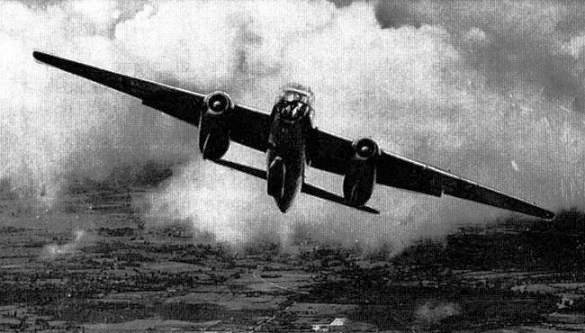
The history of the first jet bomb began in 1940, when Hitler's plans to defeat Britain in the sky collapsed. Bombers regularly fell under the fire of the Spitfires and Hurricanes, the air defense also gathered its bloody harvest, and although the fighters from the Luftwaffe drank British blood in buckets and painted the Abshussbalken systematically and regularly, Germany lost the air war.
And the company "Arado" was given a task like "come up with something like that." In the sense - a reconnaissance spotter, able to escape from fighters and be a difficult target for air defense.
Yes, they did, right? "Mosquito", about which we recently spoke. It’s hard to say who’s who, but they’re alike. And they began to be developed at one time.
So the Arado was conceived precisely as a high-speed reconnaissance, and not a bomber. Well, actually, in this role he made his debut and, moreover, achieved success.
The development of the aircraft began in 1940. How I made a close contact between Arado and Henschel, I won’t take it, but it was the Henschel gas turbine that was originally planned as the power unit for the new aircraft.
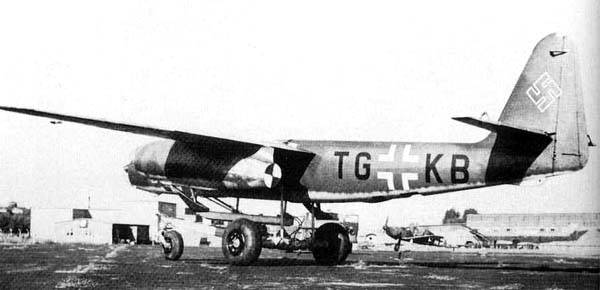
Happened. The project took real shape. Although soon after the start of work, the E370 project did not just freeze, but almost fell into a peak. This happened after General Udet, responsible for technical policy in the Luftwaffe, committed suicide. And Milkh who replaced him brought down from heaven to earth more than one project of those that used the location of Udet.
But a miracle happened, and Field Marshal Milch approved the project. He liked the clean lines of the aircraft, and Arado received the coveted order first for 6 and then for 20 machines. It remains to wait for the engines ...
Speaking of a certain originality of the Arado designers, in the first place, of course, the chassis comes to mind. Nobody had such a chassis yet.
In fact, at first the designers proposed to install nine very small wheels under the center wing, similar to the Ar.232 transport aircraft. So it was possible to keep the narrow body of the aircraft and get a bonus in terms of aerodynamic drag.
But then Ostap suffered, and in the end, what we used to see in the photographs was born: the plane took off from a special trolley, which was dumped after climbing a certain height.
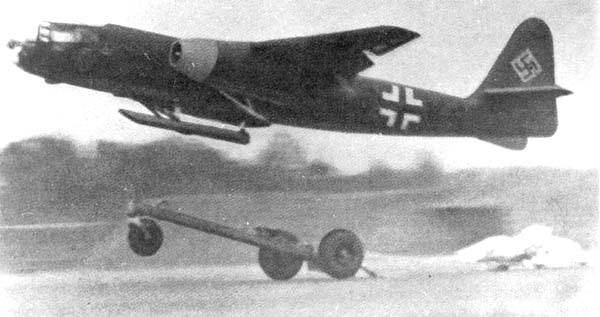
It was envisaged that the car would land on a spring-loaded landing ski, plus a parachute. And there were also small skis under the wings, also produced during landing.
According to calculations, with a take-off weight of about 8000 kg, the aircraft was supposed to reach a speed of 780 km / h at an altitude of 6000 m and reach a practical ceiling of 11000 m. The flight range was determined in 2150 km, since the entire fuselage except the cockpit could be occupied by fuel tanks.
By design, Ar.234 was a single-seat all-metal high-wing with a single-tail plumage. A detachable cockpit was attached to the fuselage with bolts, which had a duralumin frame and was covered with plexiglass on top and in front, and in other parts - with duralumin skin.
On the first aircraft (series A), all compartments were occupied by fuel tanks, but then, starting from series B, the middle compartment was used to place the main wheels of the landing gear in the retracted position.
The propulsion system consisted of two Junkers Jumo004 gas turbine jet engines, a fuel system (on Model B, consisting of a front tank with 1750 liters and a rear, 2000-liter) and a control system.
The aircraft had a full set of flight and navigation equipment, which allowed for flights day and night, including in difficult weather conditions. The VHF set-top box for the FuG16Zy radio station made it possible to use the receiver in the radio half-pass circuit. The "lung machine", which was part of the oxygen equipment system, created the pilot comfortable enough conditions at high altitudes, up to the practical ceiling of the aircraft.
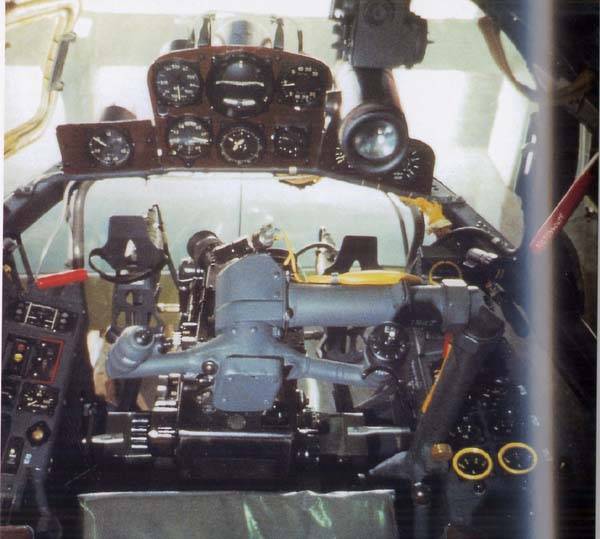
In the evening of July 30 1943 the first flight took place. Yes, the Me-262 flew much earlier, but we already had plenty of discussion about how “raw” Messerschmitt's product was. At "Arado" everything was pretty smoother and without excesses. The trolleys that are broken due to non-opening of parachutes are, in principle, trifles in comparison with the fact that the plane flew and flew well.
Then began the usual German jokes in terms of alterations. Right, is there a quick scout? And let's make him a bomber! No room for a bomb bay? Small sizes? The truck chassis does not allow to place bombs on the external sling? Well, the party (NSDAP) says that it is necessary ... Or call dad Mueller?
Of course, there was probably nothing of the kind, but Milch knew how to convince. That’s why they settled in Arado for remaking.
Since the placement of bombs inside was not even discussed, they had no place there, however, the aircraft received a normal three-post landing gear. And the entire B series already came with normal struts and wheels.
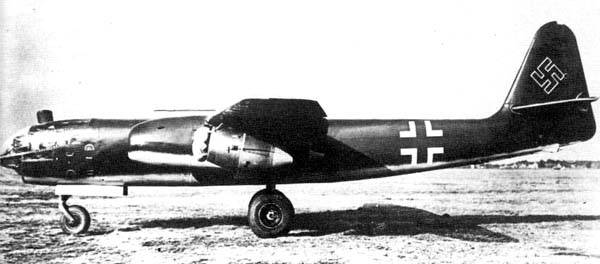
At the same time, Arado experts experimented with engines.
It is ridiculous how some “experts” say that the Germans did not create anything so perfect. Yes, the first turbojet engines were not perfect, but they were, it was possible to fly on them, and fly fast! And most importantly, unlike all the participating countries, there was a CHOICE! This is, of course, very difficult to understand, but yes.
So, while working with the Junkers engine, Arado engineers at the same time looked at what the competitors were doing. Competitors are not Rolls-Royce or Klimov. It will be much later. So far, Junkers had only one competitor - BMW. And their BMW003 engine.
Tests in the middle of the 1943 showed that the reactive BMW003, although they give traction on 40 kg less than Jumo004, are themselves lighter on 240 kg. And that at that time was quite a lot.
And the option was born: to equip a jet aircraft with four BMW003 engines. This idea was first implemented on the prototype V-6. The Ar.234 V-8 turned out to be more promising, in which each engine installation was located not separately, but in paired engine nacelles, two under each wing.
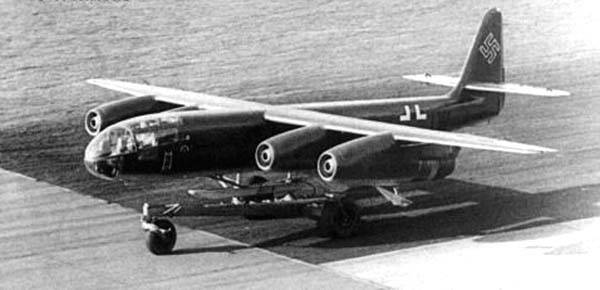
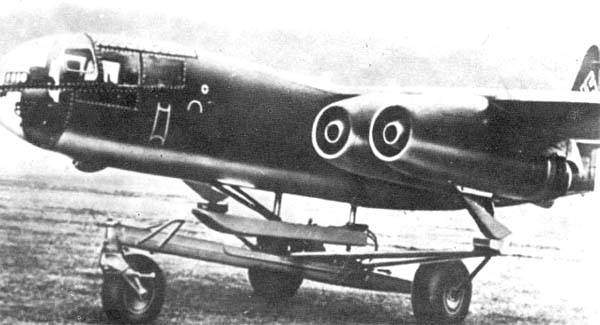
So there was a series C.
The Arado of the C series was supposed to be 100-130 km / h faster, have a higher climb rate on the 10-15 m / s, but the range was less by 140-170 km. Which is perfectly logical, for four engines cracked more fuel than two. But the speed ... The speed really approached 900 km / h, which definitely made the 234 th elusive.
Among other things, the first A-series machines worked out completely familiar things today: a pressurized cabin, an ejected pilot's seat, a parachute and take-off boosters. Designers achieved great success in testing the last two systems, and these systems, for the first time in German practice, soon became part of the standard Ar.234 equipment.
Hitler, who was shown Ar.234 in November 1943, liked the plane. The Führer ordered that at least two hundred Ar.1944 be built by the end of 234. It almost happened, because all Ar.234 was released about 150 machines.
So, at the exit, the Germans got quite a real scout with the possibility of suspension of bombs. The cart is a thing of the past, ETC pylons for bombs and a BZA bomber computer appeared.
The A.234B-2 was an aircraft capable of carrying a maximum bomb load of up to 2000 kg. Several versions of this aircraft were created, including the B-2 / b (photo reconnaissance,) B-2 / r (the leader of the bombers, equipped with additional fuel tanks).
When installing the autopilot, the letter “p” was added to the designation of the aircraft. When equipped with photo reconnaissance equipment, the letter b, and finally, machines with the possibility of installing additional fuel tanks, had the letter r in the designation. These options could also occur in combinations: for example, A.234В-2bpr.
The bomber was equipped with a three-axis Patin PDS autopilot and a Lotfe 7K tachometer bomb sight.
The method of bombing from horizontal flight was very original. When approaching the target, the pilot turned on the autopilot, unfastened his shoulder straps, threw the helm to the right and leaned toward the bomber sight. Sight control through the calculator was connected to the autopilot, so all the pilot had to do was keep the target in the crosshairs of the sight.
Upon reaching the point of bombing, the bombs were dropped automatically. And in the yard, I recall, was the 1943 year ...
After dropping the bombs, the pilot assumed the usual position, buckled up, turned off the autopilot and took control of the aircraft.
For dive bombing, the BZA bomb computer and the RF2C periscope sight were used. It was he who sticks out on the pictures in the upper part of the nose glazing of the lantern, simultaneously performing the function of a rear viewing periscope.
In August 1944, pilot Captain Sommer made his first sortie. Sommer worked out aerial photography of the Cherbourg area, where the Allied troops landed in Normandy. The pilot made three passes over the Allied landing area, after which he safely landed in Juvencourt.
The flight altitude was 10 000 meters, speed 740 km / h. For half an hour, Sommer took 380 pictures of the landing area. This, in fact, did not succeed for anyone, and the German command for almost two months did not have accurate data on the quantitative composition of the troops that landed.
It was thanks to the 24 Sommer’s flight time clock and the 22 Gotz watch that a large film was made that made it possible to estimate the number of troops crossed the English Channel. The result was not the most pleasant for the Germans.
During flights, most of which took place over the territory of Great Britain and France, the plane easily evaded the attacks of Allied fighters. In reality, neither Spitfire nor Mustang could oppose anything to Lightning if it had already been unmasked.
In September 1944, a unit was formed, called the "3 Gotz Commander." So praised the merits of both pilots and the capabilities of aircraft. In November of the same 1944 year, two more reconnaissance units were formed, called the Sonderkommand Hecht and the Sonderkommer Sperling. The last unit of photo intelligence was the Zommer Sonderkommand, based in Udine, near Trieste. The division worked, respectively, on the Italian front.
And only in October 1944, the first bomber unit was formed in Alt-Lenewitz - IV. (Erg) / KG 76. Soon it was renamed to group III./EKG 1 and besides Аr.234В-2 they gave a couple more double Me.262-В1s for training and export flights.
The first combat use of the A.234В bombers occurred in February 1945 of the year in the area of Cleve. On February 24 of 1945, during an attack, one of the III./KG 76 aircraft was shot down by the American P-47 fighter, and the Allies got the opportunity to get acquainted with the A.234.
Since the Luftwaffe was already in a fever, it is impossible to say that the use of A.234В was successful. Groups suffered from logistics, lack of fuel. The only documented success at the end of the war was the destruction of the Landesdorf bridge near Remagen.
On the whole, as a photo reconnaissance, the A.234В turned out to be much more effective. But this is not surprising, since the aircraft was created specifically for such work.
There were attempts to adapt the A.234В as a night fighter, armed with two 20-mm guns and the Neptune radar, but it turned out to be complete garbage. One person was unable to read the radar's electronic tubes and control the aircraft. As a “night lamp", A.234В did not take place.
What can be said about A.234С? Just that it was built. The four-engine aircraft made its first takeoff on September 30 of the 1944 of the year. It was practically a B-1, but with four BMW 003A-1, as well as an enlarged nose wheel and first appeared brake flaps.
On C-series aircraft, a pressurized cabin was already confidently registered. Further - more: appeared weapon. Two 20-mm MG-151 cannons with ammunition load in 200 shells each were installed in the rear part of the fixed carriages.
That is, there wasn’t even talking about any aimed fire, but the enemy fighter that came into the tail could at least be scared.
And on the C-3 version, two of the same guns appeared, firing forward. They were placed under the cabin in a hanging container. From that moment on, the A.234С turned into quite a multi-purpose aircraft.
Notice what the Germans are all the same. There is a war going on, the war is losing, the front is cracking, and they continued to drive modifications to the aircraft, the use of which was really in doubt, based on the foregoing.
And there were also modifications that were developed for engines that were "on the way": Heinkel-Heert HeS 011А or Junkers 012.
There was an attempt to use one of the C family vehicles as a carrier for the V1 cruise missile, equipping it with a parallel-logic mechanism for separating the rocket from the fuselage before launch, but they did not manage to test this modification. And so - a completely ready-made scheme of an attack missile carrier. In the 1945 year.
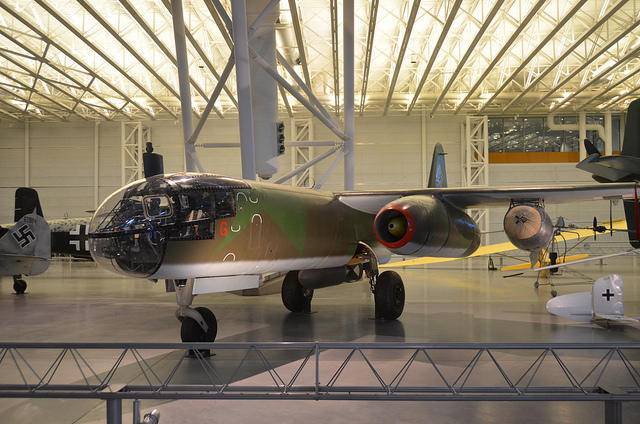
In general, I would call Ar.234 a successful machine. Yes, it was released a little, yes, the application was episodic, but ... But the aircraft confidently and successfully performed the role that it was destined for. This is a fact that is hard to get away from.
The A.234 was difficult to fly, especially on takeoff and landing, and only highly qualified pilots could actually fly it. They also improved the tactics of using such aircraft, which was very useful to our enemies / allies / opponents after the war.
Here it should be noted that all the work of Ar.234 came at a time when aviation Allies had total air superiority. Nevertheless, despite the fact that Ar.234 was used exclusively on the Western Front, the losses were small even on take-offs and landings.
British sources indicate that until 25 on March 1945, only 4 KG76 pilots died in battle, the same number in disasters and 7 were injured in accidents. Few allied fighters boasted successful interceptions of the Ar.234B.
Although the bombers, due to their small size and inability to carry a large number of bombs, could not become real weapons, the A.234В intelligence agents more than worked out all the money spent on them.
It is clear that the Allies showed great interest in the aircraft, but ours did not stand aside. The damaged A.234В aircraft made an emergency landing at the Pyutnits airfield, where it was captured by our troops.
The brigade of the Air Force Research Institute immediately began to restore the machine, and it, although not without problems, was brought into relatively flying condition. To save time, the first stage of flight tests was decided to be held in Germany. The flights were carried out first at the Pyutnitz aerodrome, and then at Rechlin and Hertz.
The conclusions made by the head of the department of the Air Force Research Institute, engineer-lieutenant colonel A.G. Kochetkov, were imprinted by the fact that he constantly compared Ar.234 with Me.262, tested the day before. Kochetkov noted that Ar.234 is less well-designed and significantly inferior in terms of flight tactical data (Soviet testers received a maximum speed of 690 km / h at 4000 m), but it is superior in range and duration of flight.
Leading engineer, major engineer I.G. Rabkin and pilot, major A.G. Kubyshkin, who arrived in Germany, after a ground study of Ar.234 from 25 on January 1946, started flying on it. However, the very next day the tests had to be interrupted due to an airplane accident. After the restoration of the aircraft, February 14 1946 g., The tests were continued, and February 26 completed. In total, we managed to complete five flights with a raid of 3 h 13 min.
After that, the aircraft finally fell into disrepair and was damaged by a fire in the last flight. The failed engine caught fire.
A.234В did not receive rave ratings from Soviet test pilots. According to our experts, the aircraft was very difficult to pilot, which was aggravated by a significant extension of the cockpit relative to the wing, insufficient lateral stability at low speeds and high loads on the control stick from ailerons at speeds above 450 km / h.
In defense, it is worth saying that the Me.262, which was tested simultaneously with the A.234В, was actually a new aircraft, and the A.234В was actually at the end of its life, and even after the repair, which was first carried out by the Germans at the end of the war, and then still ours, without, to put it mildly, the concept of an airplane.
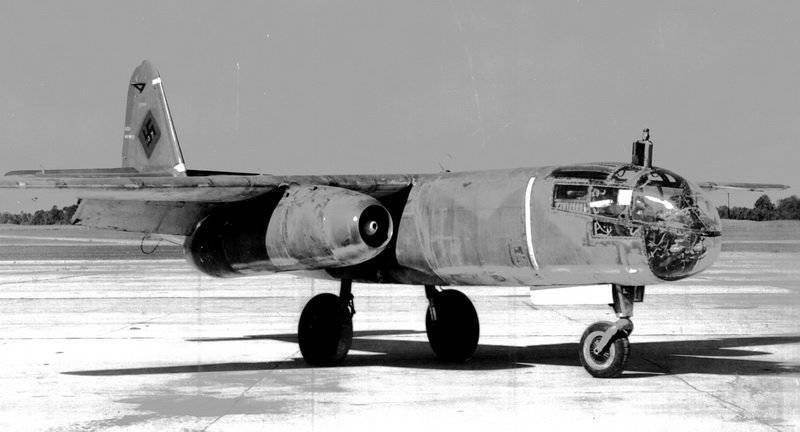
Nevertheless, it is worth paying tribute to those who were the first to develop, refine and master jet technology. In response to some “experts," I have already said that the new is always difficult and difficult. But you must admit, those innovations that were laid down in the A.234, a pressurized cabin, brake parachutes, accelerators, catapults, everything that a modern aircraft does not seem like today, was invented and tested just then, under the crunch of the Third Reich.
And it’s good that we were able to take advantage of the developments.
And it’s wonderful that the Germans could not bring to mind all their plans. For at the exit by the 1946 year we would have received squadrons of elusive bombers, which it would be very difficult to handle with conventional methods. And with unusual ones, you know, we didn’t have much.
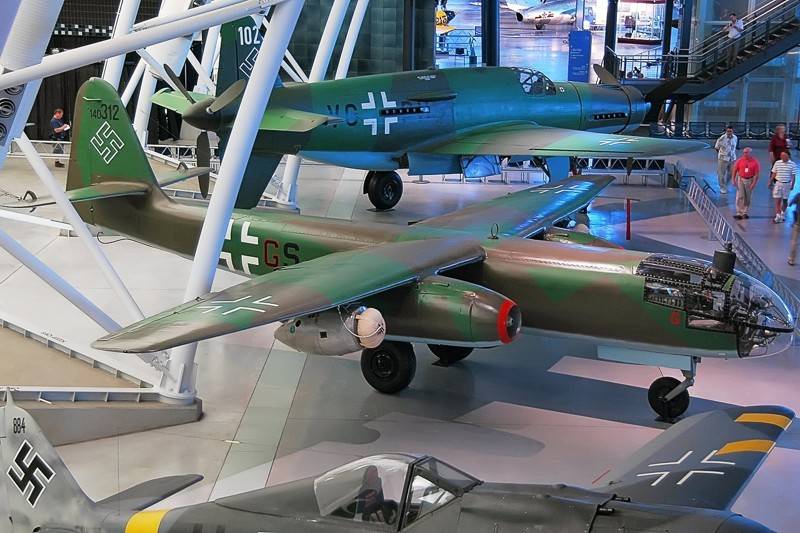
LTX A.234b-2
Wingspan, m: 14,10
Length, m: 12,60
Height, m: 4,30
Wing area, м2: 25,50
Weight, kg
- empty aircraft: 5 200
- normal takeoff: 8 417
- maximum take-off: 9 858
Engine type: 2 turbojet Jumo-004B "Orkan" according to 900 kgf
Maximum speed km / h: 740
Practical range, km: 1 620
Combat range, km: 1 100
Maximum rate of climb, m / min: 470
Practical ceiling, m: 10 000
Crew: 1
Armament:
- two fixed 20-mm MG-151 guns in the rear with 200 shells on the barrel;
- three 500-kg bombs or one 1000-kg bomb, or one 1000-kg bomb and two 350-kg bombs, or three 250-500-kg bomb cartridges.
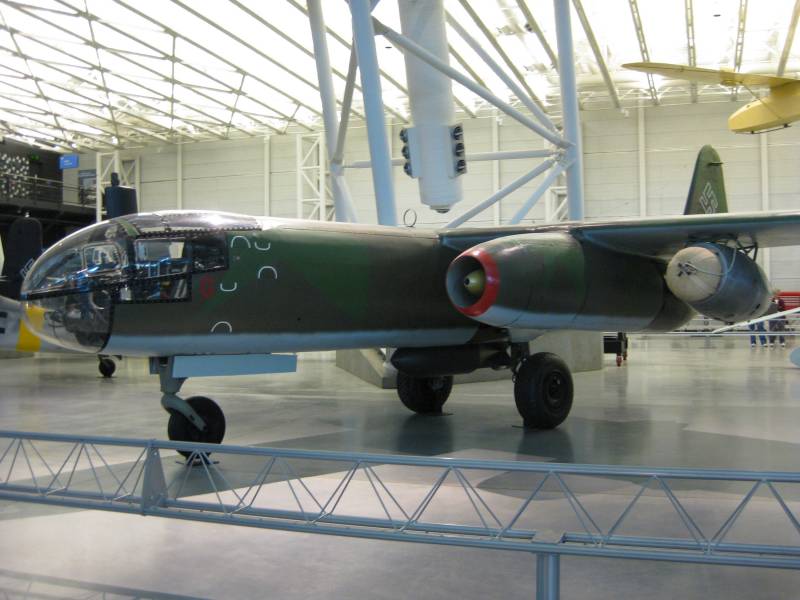
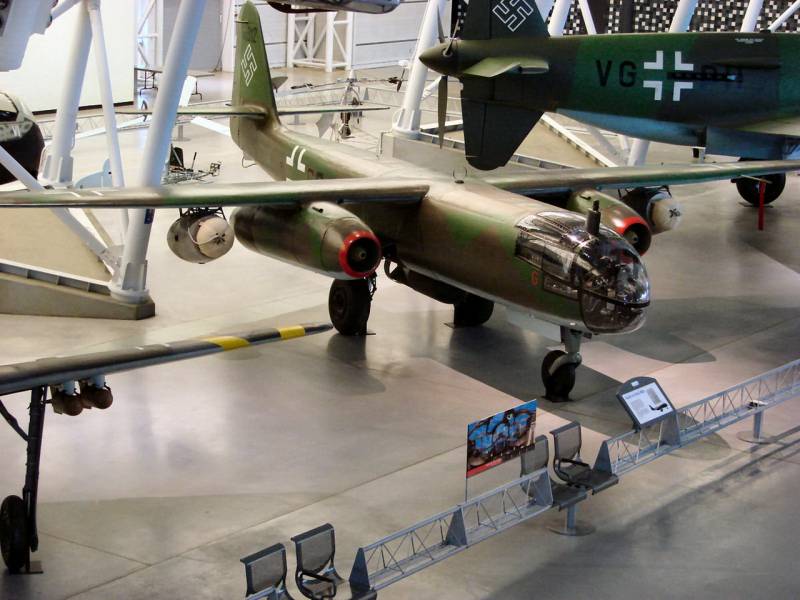
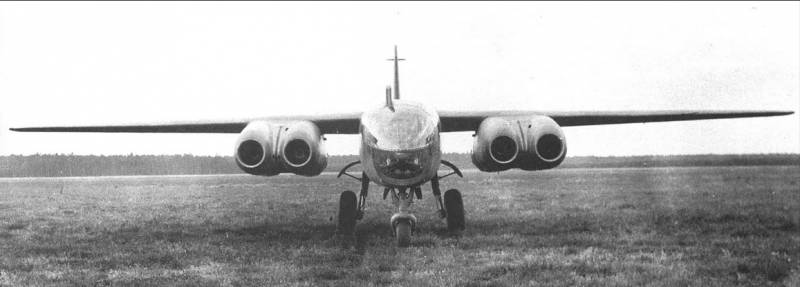
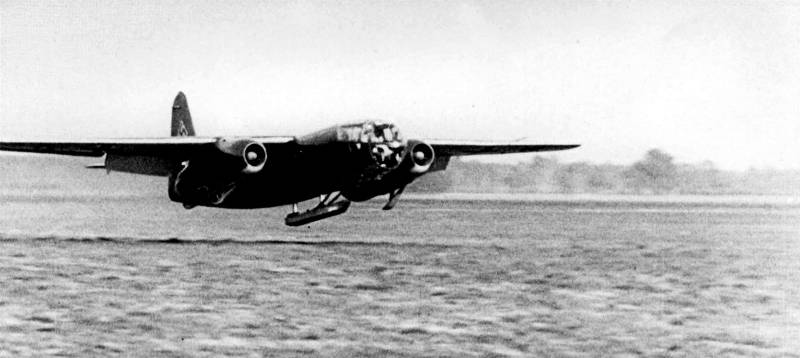
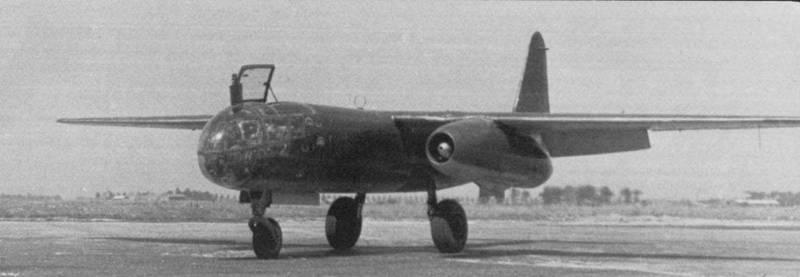
Information